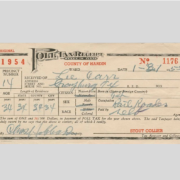Celebrating the 50th anniversary of a ruling that made the poll tax unconstitutional
By Allison Keyes, Smithsonian Magazine
In January 1955 in Hardin County, Texas, Leo Carr had to pay $1.50 to vote. That receipt for Carr’s “poll tax” now resides in the collections of the Smithsonian’s National Museum of African American History and Culture. In today’s dollars, Carr paid roughly $13.
“It’s a day’s wages,” explains William Pretzer, the museum’s senior history curator. “You’re asking someone to pay a day’s wages in order to be able to vote.”
Pretzer says the museum accepted the donation of the receipt from Carr’s family in 2012 as a vivid and a significant example of the way that voting rights were denied to African Americans. Poll taxes, quite simply a tax to pay to vote, were enacted in the post-reconstruction era from the late 19th to the very early 20th century. But they remained in effect until the 1960s.
Featured Image, James Estrin for The New York Times
Full article @ Smithsonian Magazine

